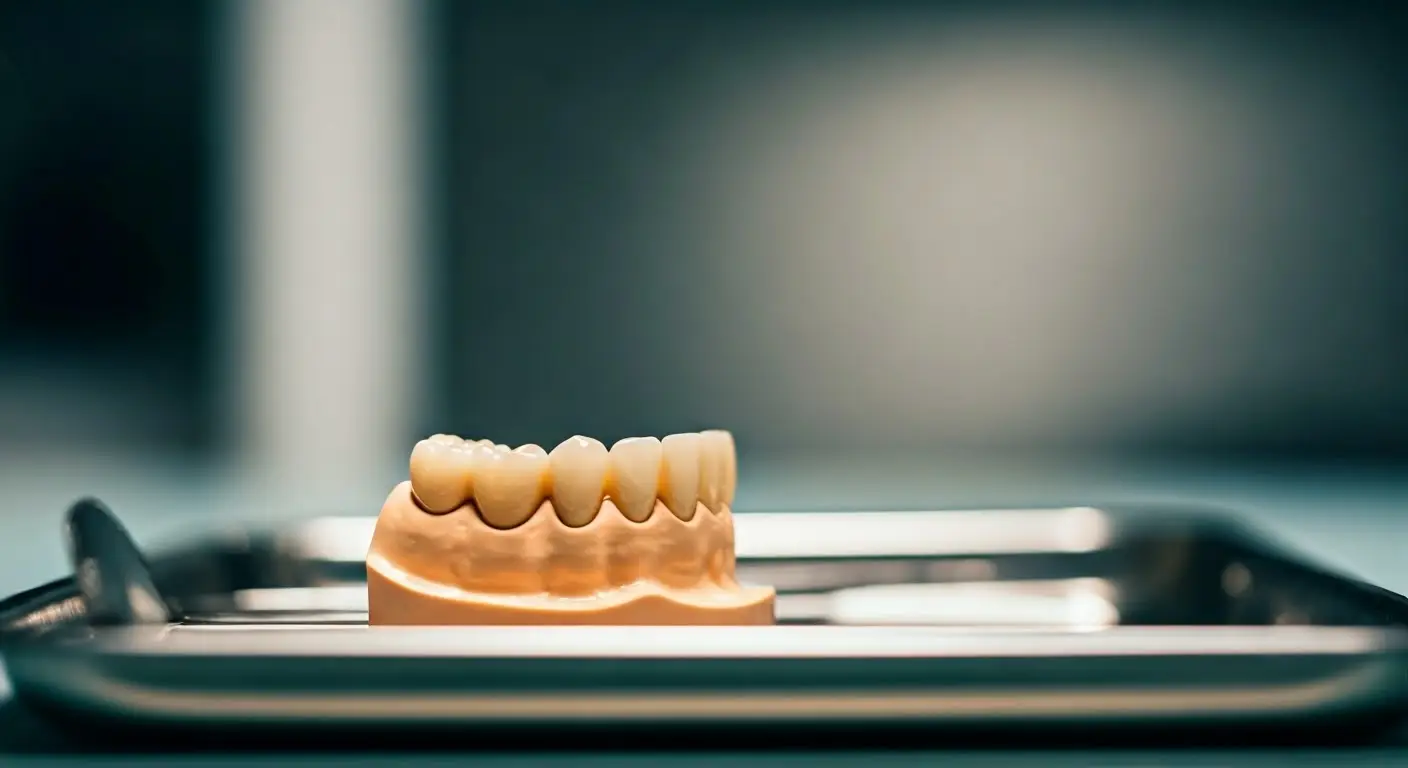
Key Highlights
- Dental crowns are caps that go over damaged teeth. They help to fix their function and look.
- Crowns can chip if you bite hard things, have an accident, or through regular wear.
Signs of a chipped crown are visible damage and sensitivity.
- If you have a chipped crown, rinse your mouth and use temporary dental cement right away.
- A dentist can either fix or replace a chipped crown. The choice depends on how bad the damage is.
Introduction
Experiencing a dental emergency, like a chipped crown, can be scary. The area may feel sensitive or hurt a lot. It is important to understand the cause and symptoms of a chipped crown. This knowledge helps you get the right care and keep your teeth healthy. This blog post talks about common worries related to chipped crowns. It gives you tips on what to do right away and what professional help is available in Mission Viejo.
Understanding Dental Crowns in Mission Viejo

Dental crowns are an important part of cosmetic dentistry and dental services. They are special caps made to fit over a damaged tooth completely. A permanent porcelain crown helps to make weak teeth stronger, fix damaged ones, and improve the look of your smile. Crowns throughout history have served both functional and aesthetic purposes, reflecting the advancements in dental technology and materials. From ancient civilizations using gold and porcelain to modern-day techniques, the evolution of crowns showcases the commitment to improving oral health and enhancing smiles. Today, dental crowns are custom-made to match the natural tooth color, ensuring a seamless blend with your existing teeth.
Dentists use dental crowns for many reasons. They cover a tooth after root canal treatment, protect a cracked tooth, or hold a dental bridge in place. Crowns can also be used to prevent a fracture in a weak tooth. Knowing about the different types of crowns and their benefits can help you make better choices for your dental health.
The Role of Dental Crowns in Oral Health
Dental crowns are important for keeping your natural tooth and overall oral health safe, especially when dealing with a cavity. A crown covers the entire tooth and adds strength. It helps stop further damage and helps the tooth work properly again.
A crown serves as a protective layer for teeth that are weak from decay, cracks, or lots of dental work. It spreads out the force when you bite, which helps reduce the risk of more damage or breaks. This safety means you can eat and speak without pain.
Crowns also protect the tooth underneath from bacteria. When a tooth is hurt, it can attract harmful bacteria that cause decay. A crown keeps these weak spots sealed off and helps prevent more decay. This means you may avoid needing serious dental work later on.
Types of Dental Crowns and Their Durability
Several types of dental crowns are available, each offering a unique blend of aesthetics and durability, especially for molars:
|
Crown Type |
Material |
Pros |
Cons |
|
Gold, Palladium, Nickel, Chromium |
Extremely durable, long-lasting, affordable |
Not aesthetically pleasing, potential for allergic reactions |
|
|
Porcelain-Fused-to-Metal Crowns |
Porcelain fused to a metal base |
Natural-looking, durable |
Porcelain can chip, potential for metal showing through |
|
All-Porcelain or All-Ceramic Crowns |
Porcelain crowns or ceramic |
Highly aesthetic, biocompatible |
Can wear down opposing teeth over time, more expensive |
Your dentist will help you choose the best crown based on the location of the tooth, its function, aesthetic concerns, and cost considerations.
Identifying a Chipped Crown: Symptoms and Immediate Actions

Noticing a chipped crown early is very important. It helps prevent more damage and lets you fix the problem right away. When you see the signs, you can get dental care quickly. This reduces risks and helps keep your crown and tooth safe.
If you think your crown is chipped, act fast. Even if it’s not a serious dental emergency, any harm to your crown should be checked by a dentist as soon as you can.
Recognizing the Signs of a Chipped Crown
A chipped crown can have several clear signs. It’s important to watch for these to keep your oral health in check.
The first sign is visible damage. You may see a chip, crack, or a piece that is missing from the crown. These details are usually easy to spot if you look closely.
You may also feel discomfort or sensitivity in the affected area. The chip can reveal the tooth structure underneath. This part may be sensitive to hot or cold foods, pressure, or sweets.
Additionally, check for any sharp edges around the chip. The rough surface of a chipped crown can hurt your tongue, gums, or the inside of your cheeks, causing discomfort and possible cuts or sores.
First Steps to Take After Discovering a Chip
Finding a chip in your dental crown can be worrying. Here’s what to do:
- Rinse Your Mouth: Start by rinsing your mouth with warm water. This can help clean the area and remove any bits of debris. Don’t use mouthwash or strong solutions, as they could hurt the exposed tooth.
- Handle Discomfort: If you feel any soreness, try using dental pain relief from the store as instructed. You can also use dental wax on any sharp edges to help reduce irritation.
- Use Temporary Material: Think about using temporary dental cement, which is often available at drugstores. This can cover the chip and protect the tooth from further damage while you wait for your dental visit.
Professional Solutions for a Chipped Crown in Mission Viejo
Temporary solutions may offer quick help, but seeing a dentist in Mission Viejo is key for a proper check-up and long-term care. Dentists know how to look at the damage closely. They can suggest the best steps to take to fix your chipped crown well.
With modern methods and custom treatment plans, a dentist can bring your chipped crown back to how it should be with proper care. These expert solutions provide lasting and good-looking results, helping you smile with confidence again. Additionally, it’s important to recognize loose dental crown symptoms, such as sensitivity to temperature or discomfort when biting down. Addressing these issues promptly can prevent further damage and ensure the longevity of your dental work. With the right approach, your restored crown can blend seamlessly with your natural teeth, enhancing both aesthetics and functionality.
When to See a Dentist for a Chipped Crown
Even a small chip in your dental crown may not seem like a big problem. However, it’s always a good idea to be careful and book an appointment with your dentist. They can check the damage and suggest what to do next.
If you feel a lot of pain, have sensitivity, or if the chip is large and affects the strength of your crown, get dental help right away. Waiting to treat these issues, especially if anesthesia is needed, may cause more serious problems, like infection or losing the tooth.
A dentist is the best person to help keep your dental crown healthy and lasting a long time. Moreover, practicing good dental hygiene, along with regular dental visits and quick action on any issues, can help you avoid more damage and keep your smile looking great for many years.
Treatment Options Available for Chipped Crowns
Depending on how bad the chip is, there are several ways to fix a chipped crown:
- Composite Resin Repair: For small chips, your dentist can use composite resin. This is a tooth-colored filling that fixes the damage. It is a fast and painless way to make your crown look and work like before.
- Dental Crown Re-Cementation: If the crown is still in one piece but has come loose, the dentist will clean both the crown and the tooth. He will then use dental cement to stick it back in place.
- Custom Crown Replacement: If the chip is large or the crown is old and worn down, your dentist may suggest getting a new crown. This process includes taking impressions of your teeth to make a custom crown that fits well and looks just like your natural teeth.
Conclusion
In conclusion, acting fast when you find a chipped crown is very important for your oral health. It is good to know the signs of a chipped crown. If you’re bleeding, applying a piece of gauze and seeking help from a dentist quickly can stop more problems from happening. Keep in mind, the strength of dental crowns depends on the material they are made from. If you feel discomfort or see any damage to your crown, talk to a dentist in Mission Viejo right away. Your oral health matters a lot, so address chipped crowns quickly to keep your smile healthy and confident. If you have any questions or worries, book an appointment with a dental professional for the care you need.
Frequently Asked Questions
Can a chipped crown cause pain or sensitivity?
A chipped crown can show the tooth structure underneath, including the protective enamel layer. This makes the affected area more sensitive and can lead to pain. It can hurt more when you eat cold foods or put pressure on it.
How quickly should I seek treatment for a chipped crown?
If you have a dental issue, it’s good to call your dentist right away. They can look at your symptoms and tell you how urgent it is. They will also help you know if you need to act quickly to stop any further damage.
Are there temporary solutions for a chipped crown until I can see a dentist?
You can use temporary dental cement or dental repair resin to cover the affected area. This will help protect it from further damage and reduce discomfort. This is a good option until you can see your dentist.
How can I prevent my dental crowns from chipping in the future?
- Take care of your teeth by not chewing hard foods.
- Use a mouth guard if you grind your teeth, known as bruxism.
- Go to your regular dental visits for check-ups and cleanings.
Does dental insurance typically cover the repair or replacement of a chipped crown?
Dental insurance can be different for everyone. Many plans do cover dental services for a broken crown. This includes both repairs and new crowns. It’s a good idea to check with your insurance provider to know what is covered for you.

